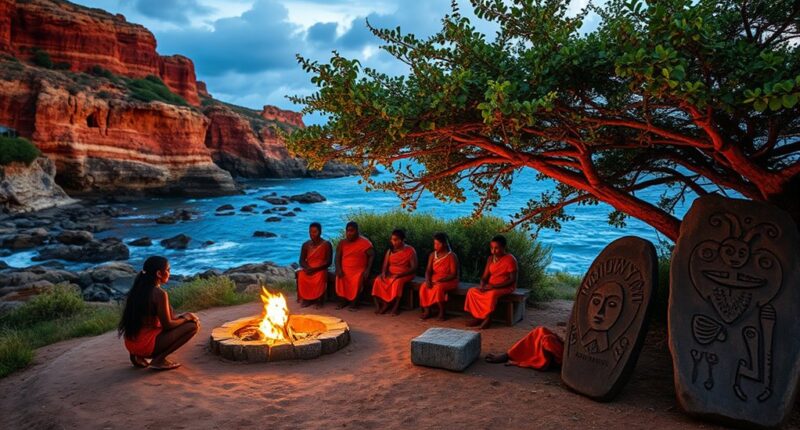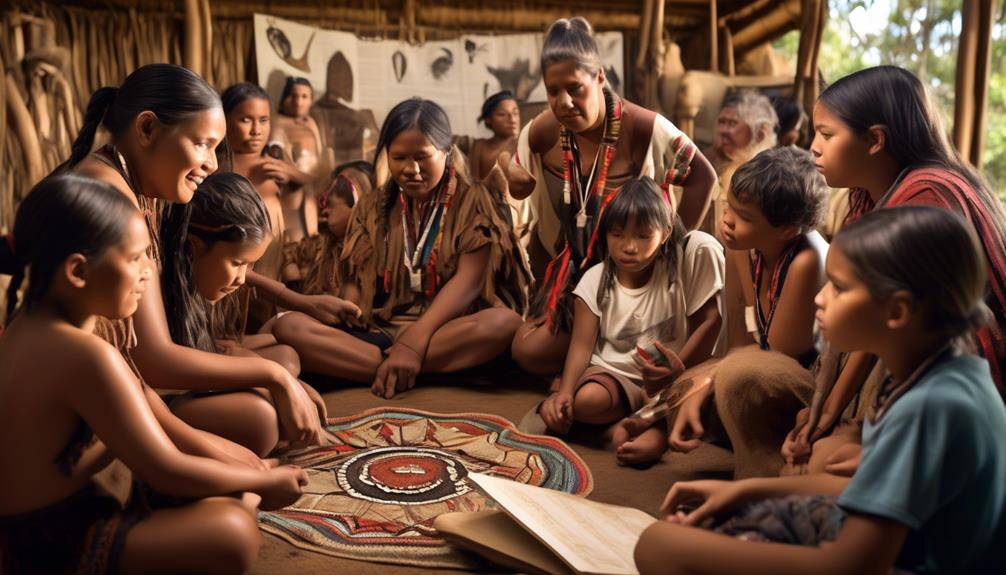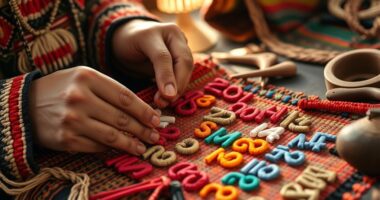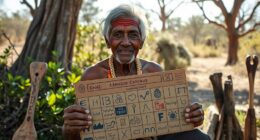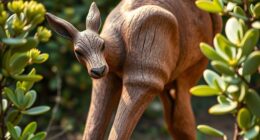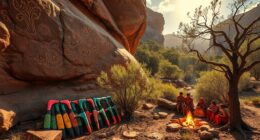Dhuwaya and Yolngu Matha are essential living languages in Arnhem Land, reflecting the region’s rich cultural heritage. Dhuwaya, spoken by a smaller community, remains an important part of local identity despite challenges, while Yolngu Matha covers several related languages used widely in ceremonies, art, and daily life. These languages embody history, spirituality, and cultural strength, and active efforts are underway to preserve and revitalize them. Discover how these languages continue to thrive and shape Arnhem Land’s vibrant culture.
Key Takeaways
- Dhuwaya and Yolngu Matha are vital Indigenous languages in Arnhem Land, representing distinct cultural identities.
- Yolngu Matha encompasses several related languages used for communication, ceremonies, and art among Yolngu people.
- Dhuwaya, spoken by a smaller community, remains a crucial part of local heritage despite challenges.
- Both languages are actively preserved through community-led initiatives, education, and storytelling efforts.
- They embody cultural values, history, and spirituality, underscoring their importance for cultural continuity.

Arnhem Land, a remote region in northern Australia, is home to a vibrant tapestry of Indigenous languages that thrive despite modern challenges. As you explore this area, you’ll quickly notice the remarkable linguistic diversity that characterizes its communities. These languages are more than just words; they’re essential expressions of culture, history, and identity. Yet, maintaining this diversity isn’t easy. Many of these languages face threats from shifting social dynamics, intergenerational gaps, and the dominance of English. Despite these obstacles, efforts to preserve and revitalize these languages continue, reflecting their significance to the people of Arnhem Land.
You play a role in understanding the importance of language preservation here. Many local communities actively work to keep their languages alive through education, storytelling, and cultural practices. Schools in Arnhem Land often teach children in their native languages alongside English, ensuring that future generations can speak and pass on their linguistic heritage. Community elders serve as custodians of language, sharing stories and traditional knowledge that embody the essence of their culture. These initiatives help sustain the unique linguistic landscape of the region, emphasizing that language is not just communication but a repository of history, worldview, and spirituality.
When you engage with the languages of Arnhem Land, you’ll encounter Dhuwaya and Yolngu Matha among others—each with its own complex structure and rich vocabulary. Dhuwaya, spoken by a smaller community, faces particular challenges but remains an integral part of local identity. Yolngu Matha, a collective term for several closely related languages, is more widely spoken and serves as a foundation for cultural cohesion among the Yolngu people. Both languages are actively used in ceremonies, art, and daily conversation, demonstrating their resilience and ongoing relevance. Recognizing the importance of these languages means supporting community-led initiatives that promote their use and transmission.
Ultimately, your understanding of Arnhem Land’s linguistic diversity highlights the importance of language preservation, which is crucial for maintaining cultural identity and knowledge. These languages are living entities, continuously evolving as they adapt to contemporary life while maintaining their deep roots. By valuing and supporting efforts to keep these languages vibrant, you contribute to safeguarding a crucial part of Australia’s Indigenous heritage. In doing so, you help guarantee that the voices of Arnhem Land’s people continue to resonate for generations to come, preserving their stories, traditions, and identity in a rapidly changing world.
Frequently Asked Questions
How Many Speakers Currently Use Dhuwaya and Yolngu Matha?
You’ll find that Dhuwaya has around 2,000 speakers, mainly among elders and community members in Arnhem Land, showing moderate language liveliness. Yolngu Matha, on the other hand, boasts approximately 3,000 speakers, with a strong presence among Yolngu people, especially in coastal communities. Both languages’ speaker demographics highlight their cultural importance, but ongoing efforts are essential to sustain their vitality and pass them on to future generations.
Are These Languages Taught in Local Schools or Universities?
Imagine a vibrant tapestry of culture woven into local schools and universities. You’ll find that language policies increasingly support teaching Dhuwaya and Yolngu Matha, integrating them into academic programs. These efforts aim to preserve and revitalize these languages, ensuring future generations can speak and celebrate their heritage. By embracing these languages within educational settings, you help keep the rich stories and traditions alive, like a song passed down through time.
What Efforts Are Underway to Preserve and Revitalize These Languages?
You can support efforts to preserve and revitalize these languages by participating in community language programs and promoting linguistic documentation. Local communities often run language workshops, cultural activities, and educational initiatives that encourage speaking and learning Dhuwaya and Yolngu Matha. Additionally, governments and organizations fund linguistic documentation projects, which record and analyze the languages, ensuring their survival for future generations. Your involvement helps keep these essential cultural expressions alive.
How Do Dhuwaya and Yolngu Matha Influence Local Culture and Traditions?
You influence local culture and traditions through traditional storytelling and cultural ceremonies, which are central to community identity. Dhuwaya and Yolngu Matha serve as essential vessels for passing down stories, beliefs, and customs. By speaking these languages, you keep rituals alive, strengthen social bonds, and guarantee future generations understand their heritage. Your use of these languages sustains the rich cultural fabric of Arnhem Land, fostering pride and continuity.
Are There Any Digital Resources or Apps Available for Learning These Languages?
Yes, you can find digital language resources and apps to learn Dhuwaya and Yolngu Matha. These language learning apps offer audio recordings, vocabulary, and interactive lessons that make it easier to grasp the pronunciation and grammar. You should explore online platforms and websites that focus on Indigenous languages. Using these digital language resources, you can actively engage with the languages, helping you preserve and understand these rich cultural traditions.
Conclusion
You see, dhuwaya and Yolngu Matha aren’t just languages—they’re essential threads in Arnhem Land’s rich cultural fabric. Did you know that over 90% of the local community still speak these languages daily? That’s a powerful reminder of their resilience and importance. By preserving them, you’re helping guarantee these voices continue to tell stories, share knowledge, and keep traditions alive for generations to come.
Mary is a passionate writer who brings creativity and a fresh perspective to our team. Her words have the power to captivate and inspire, making her an essential contributor to our content. Mary’s commitment to storytelling and dedication to promoting Indigenous culture ensures that her work touches the hearts of our readers. We’re fortunate to have her as part of our team.
